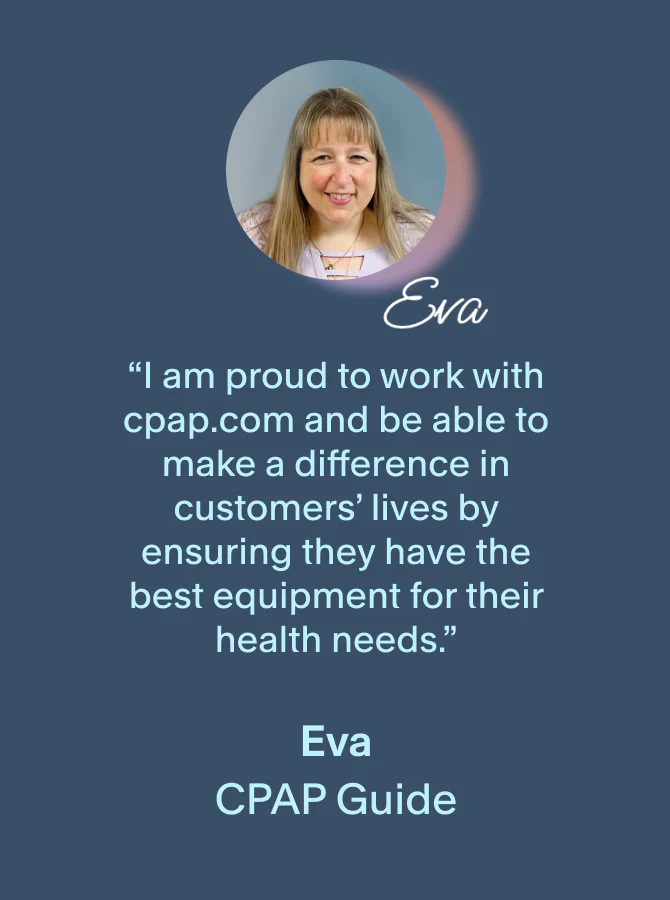Our content undergoes rigorous expert review, evidence-based research, and regular updates for accuracy.
If you are new to Continuous Positive Airway Pressure (CPAP) therapy and find yourself waking up with a dry mouth, scratchy throat, or irritated nostrils from your CPAP equipment, you’re not alone. CPAP therapy by itself, at times, can be dry and irritating especially in climates with low humidity or long winter months. Adding a CPAP humidifier to your therapy is one of the best ways to increase therapy efficiency, comfort, and overall CPAP compliance.
In this article, we’ll explain how a CPAP humidifier works, when you should consider adding one to your sleep therapy regimen, and how humidification can improve your quality of life by reducing common CPAP side effects like dry nose and nasal congestion.
What is a CPAP Humidifier?
A CPAP humidifier is an external or integrated device designed to add moisture to your therapy air. Unlike a traditional humidifier that adds moisture to an entire room, a CPAP humidifier is typically much smaller and is designed to only be used with a CPAP machine. There are three main design styles to be aware of:
- Integrated Humidifiers, which are designed specifically for a particular machine and will not work with any other therapy device. The DreamStation line from Philips Respironics features a modular integrated humidifier design, as does Apex Medical’s XT-Series Humidifier.
- Built-In Humidifiers, which are designed as part of the machine and cannot be removed, replaced, or repaired independently of the PAP machine. The iCH II Auto and ResMed Airsense 10 both feature a built-in humidifier.
- Standalone Humidifiers, which can be used externally with any CPAP device that uses standard-sized tubing. Fisher & Paykel’s HC150 is a good example, but standalone humidifiers aren’t as common as they once were.
There are also two main types of CPAP humidifiers available, with a third wildcard option we’ll talk about a little later.
The Two Types of CPAP Humidifiers
Outside of their fundamental design characteristics, CPAP humidifiers can be broken down into two further categories: heated and non-heated (passover).
Passover humidifiers are also referred to as cold humidifiers, or even non-electric humidifiers since they don’t draw electricity to heat the water. Heated humidifiers typically have a small heating plate that the water chamber sits on which can adjust the humidity setting based on the temperature level.
The majority of humidifiers are heated, but any CPAP humidifier can be used as a passover humidifier when the heating element is turned off.
How Does a CPAP Humidifier Work?
A CPAP humidifier works by adding moisture to your therapy air as it passes over a water chamber on its way from your CPAP machine to you. The first CPAP humidifiers all featured this basic passover design, but after a few years, heated humidifiers started to become more and more common.
While cold air is denser and actually holds more oxygen, hot air does a much better job of holding water. For this reason, passover humidifiers cannot be adjusted to provide more humidification without being heated.
The best-heated humidifiers on the market feature adjustable heat and humidity settings, but even on lower settings there are still many people who find heated humidification to be too intense.
What is the Benefit of a CPAP Humidifier?
The main benefit of a CPAP humidifier is relief from common CPAP side effects such as:
- Dry Mouth
- Sore Throat
- Inflammation of the Nasal Passage
- Congestion
- Irritation of the Airway
- Nosebleeds
This solution, however, seems to be pretty hit-or-miss and illustrates how everyone has a different picture of what therapy success looks like for them. While plenty of people have found a humidifier to greatly improve their quality of life, seemingly just as many prefer plain-and-dry CPAP therapy.
A 2002 Karger Journal study found a distinct divide in the experiences of those undergoing CPAP therapy with and without a humidifier. 47.7% of the sample size reported a better night’s sleep after using CPAP with a humidifier, while 52.3% said their therapy was more pleasant without a humidifier in use.
However, a 2010 study published in Sleep and Breathing found that compliance with the use of a heated humidifier did not increase, but patients experiencing common CPAP side effects such as congestion, dry mouth, and airway dryness found relief through the use of a humidifier with their therapy.
Further supporting this idea is a 2011 study from the European Respiratory Journal, which found no significant differences in the compliance of patients who used a heated humidifier and those that did not, but did find that problematic symptoms associated with CPAP therapy were reduced by the introduction of a heated humidifier.
In short, the main benefit of a CPAP humidifier is that it can increase your level of comfort by reducing the severity of typical CPAP side effects. Using a humidifier is, however, a very personal choice and is not a one-size-fits-all solution for nasal dryness, congestion, or irritation.
It’s also worth noting that a humidifier may be the difference-maker in your ability to tolerate CPAP therapy while suffering from Cold and Flu-like symptoms. While it’s not necessary to use a CPAP humidifier all of the time, it could be beneficial to use it when you’re not feeling your best.
CPAP Humidifier Cons: CPAP Rainout
One of the most common complaints about using a CPAP humidifier comes from people experiencing CPAP rainout. Rainout is the sudden splash of water that reaches your face due to the collection of condensation in the CPAP tube.

Rainout occurs because the air molecules carrying the moisture cooled past the dew point on their way from your humidifier to your mask, raising the relative humidity of the air and straining its ability to hold moisture. Since heated humidifiers tend to raise the temperature of your therapy air to be hotter than the air of the room you’re in, it’s very easy for your therapy air to lose temperature on its way to you due to a cold hose.
If your machine is at a higher resting position than your mask, the condensation that forms in the tube can drip down to you and wake you up or even cause a pseudo-drowning sensation.
Luckily, there are a few things you can do to prevent this:
- Raise the Temperature of the Room - Your therapy air may be cooling too much on its way through your tube, causing the rainout. By raising the temperature of your sleeping environment, you raise the amount of water that can be held by your therapy air before it condenses.
- Try Using a Passover Humidifier Instead - When your therapy air isn’t being heated past room temperature, it’s more difficult for rainout to occur in the tube. While you’ll receive less moisture overall, you’ll also reduce your chances of your sleep being interrupted due to water dripping on your face. You can also simply turn the heating element of your humidifier off to enable passover humidification.
- Use a SnuggleHose Tube Cover - This is another easy solution for keeping your hose insulated, thus allowing your humidification to reach your mask more efficiently.
- Use a Heated CPAP Hose - Heated tubing can greatly reduce rainout by keeping a consistent temperature throughout the hose and is easily the best solution for eliminating condensation buildup.
- Physically Lower Your CPAP Machine - The drowning effect that can happen with excess rainout can be slightly alleviated by lowering the position of your CPAP machine so that the tube is traveling up to you, rather than down. Water won’t be able to run up your tube and into your mask if you sleep at a higher position than your therapy device.
- Run Your Hose Under Your Comforter or Mattress - If you’d prefer not to buy anything, you can always try insulating your hose by running it under your mattress or comforter to insulate it from colder air in your bedroom.
- Some APAP Machines Also Feature Rainout Reduction Features

Many people are also turned off by the constant upkeep required to keep their humidifier running at peak condition or constantly having to have a supply of distilled water on hand.
While there are some cleaning products available to help make this process a bit easier, sadly, there is no better solution than committing to the daily upkeep of your humidifier and accounting for that time in your morning routine.
Do I Have To Use the Humidifier on My CPAP Machine?
No. While many people find that using a humidifier with their sleep apnea therapy to be helpful and beneficial, there are seemingly just as many people that swear by not using a CPAP humidifier.
In fact, a 2018 meta-analysis of nine studies found that heated humidification, on average:
- Did not improve PAP usage time
- Did not improve the patient’s Epworth Sleepiness Scale Rating
- Did not enhance compliance for CPAP or APAP patients
- Was not effective for people with OR without preexisting conditions before starting PAP therapy
- Did not improve the experience of people with upper respiratory symptoms prior to PAP therapy
While many people report success stories and give all thanks to their humidifier, there is actually no conclusive evidence in support or against using your passover humidifier because everyone has a different experience with humidification. It is an entirely personal choice that you should make based on your own comfort levels during therapy.
If you decide to stop using your humidifier and find that nasal dryness returns, a saline nasal rinse may be helpful in alleviating your symptoms.
Heated vs passover: When Would You Use a Passover Humidifier?
If you find that you’re someone who is much more sensitive to heated humidification and it doesn’t add to your comfort levels but you still suffer from dryness and congestion, it may be beneficial for you to try passover humidification instead. Passover humidifiers also typically work better for those with lower therapy pressure settings and those that live in an already-humid climate.
Your nasal mucosa is key in triggering your immune response to foreign pathogens and allergens that enter through the nose and needs moisture in order to work properly. A very common issue with CPAP therapy, especially for those that use a nasal or nasal pillow mask, is dryness of the nasal cavity, mouth, and throat.
A CPAP humidifier can be used to help combat the drying of the nasal mucosa to prevent congestion and irritation of the nasal passages and throat. Since heated air carries more moisture, many people resort to turning up the dial on their humidifier for greater relief.
For some people, this works perfectly fine, but many users on CPAPtalk.com report that the intensity of the heat was simply too much in the other direction, even on the lowest heat setting, and actually caused them more discomfort than therapy without humidification.
There are a few preexisting conditions that can make you more sensitive to too much heat in the soft tissues of your respiratory system, and recipients of UPPP surgery tend to be more sensitive as well.
There are also quite a few medications that have a drying effect on the body. Antidepressants, antihistamines, antipsychotics, benzodiazepines, blood pressure medication, anticholinergics, stimulants, analgesics, and diuretics are typically associated with drier nasal passages. If you’re taking a medication in any of the categories listed above, and especially if you’re taking several of them, using a CPAP humidifier may help you experience less dryness and discomfort.
Lastly, living in an arid climate with very low humidity is a good cause for introducing a cold humidifier to your CPAP therapy. The winter months are also especially arid, so seasonal humidification may be beneficial if your symptoms get worse with cold weather.
Heat-Moisture Exchangers, HumidX, and HumidX Plus
A heat-moisture exchanger (HME) is a waterless humidification device that connects to the front of your CPAP mask to use the moisture captured from your own exhalation to provide a low level of humidity to your air intake during therapy. HumidX and HumidX Plus are simply larger versions of this concept designed specifically for specialized masks for the ResMed AirMini.
These devices are great for traveling, as they do not require the use of distilled water and can easily fit wherever you store the rest of your equipment while traveling. These devices work better the closer they can be to your face, so some mask types do not work as well with HMEs as others.
The standard HME unit is designed to last for 7 days before requiring replacement, but HumidX and HumidX Plus can be used for up to thirty days before needing to be replaced.
If you experience rainout, find heated humidification to be too much for you, or simply hate the upkeep associated with a CPAP humidifier, an HME might be a good option for you! This is also a good option if you live in a drier climate or have limited access to distilled water.
CPAP Humidifier cleaning and replacement schedule
What Type of Water Should I Use in my CPAP Humidifier?
Distilled water is considered to be the gold standard for filling your humidifier because it has been purified of almost all external minerals, heavy metals, and contaminants that are typically found in tap water. While it’s okay to occasionally use tap water in a pinch, we strongly advise against making a habit of it.
Tap water is, of course, typically fine to consume, but when it comes to your CPAP machine, the minerals and metals found in tap water can create deposits and buildups in your machine over time, potentially damaging your machine or making it work much harder.
If you’re curious about the debate surrounding what water to use with your CPAP device, we go into more detail in CPAP Water: Distilled vs. Tap.
How to Clean Your CPAP Humidifier
If you opted for a dishwasher-safe humidifier chamber for your machine, congratulations! Your only maintenance involves emptying your water chamber each morning and rinsing it out, then running it through the dishwasher once each week.
If, however, your machine is like most and came with the standard, non-dishwasher-safe water chamber, your maintenance is a bit more involved.
Your machine most likely has its own instructions for cleaning and maintenance, so the first thing you should do is consult your user manual and make sure you understand how to remove your humidifier chamber and disassemble it.
From here it’s pretty simple: empty and rinse your chamber daily, preferably in the morning right after you use it. Standing water harbors harmful bacteria and can grow into some nasty illnesses if left unchecked for several days. While you don’t have to use soap during your daily rinse, it is most certainly recommended. If you’re not using soap daily, make sure you have at least one good cleaning per week.
After you’ve cleaned your water tub, be sure to let it dry out of direct sunlight with plenty of air circulation for a few hours before use.
During your weekly cleaning, be sure to also remove any rubber seals/gaskets and give them a good cleaning as well, making sure to properly seat the seals upon reassembly.
Keep up with this regular cleaning schedule and visually inspect your humidifier chamber for cracks in the housing or cloudiness of the plastic once a month and replace if necessary. Your humidifier chamber should last between 6 months and a year before requiring replacement per most manufacturer guidelines, but with good maintenance, you can easily get a few years out of your water chamber.
We offer a range of cleaners and sanitizing solutions for your CPAP machine, but a mild dish soap will do the trick just fine. You can also use a half-and-half mixture of white vinegar and water for sanitizing purposes. If you have a Lumin Wand or CPAP Mask and Accessories Cleaner, you can use these to sanitize your equipment after rinsing as well. There are, however, a few things you should NEVER use to clean your CPAP humidifier, including:
- Bleach
- Antibacterial Soap
- Chlorine, Ammonia, or Alcohol-Based Cleaners
- Soaps that Contain Glycerine
- Lotion-Based Cleaners/ Moisturizing Soaps
The FDA also strongly states that ozone cleaners are not safe for use with CPAP equipment, and also reminds people that UV sanitizers have not yet proven their efficacy.
Ultimately, you can decide for yourself how comfortable you are with your own germs and where your cleaning habits land. These are the official recommendations for total peace of mind and removing the guesswork from keeping your equipment clean, but many forum users describe more lax cleaning habits that work perfectly well for them, too.
Can I Put Essential Oils or Other Scents in My CPAP Humidifier?
Under no circumstances should you add essential oils directly to your humidifier. Not only is this potentially hazardous to your health, it will also quickly lead to buildup and deposits in your humidifier, risking your warranty and the operation of your machine.
While aromatherapy is well-documented to have positive effects and can even help with allergy symptoms, using oils directly in your water chamber can easily lead to inhaling far too much fragrance over the course of the night, exposing you to potentially toxic oils.
Instead, we offer a beginner aromatherapy kit that allows you to introduce essential oils to your CPAP therapy in a safer, healthier way.
Instead of placing oils into the machine, you’ll add a drop or two to a cotton diffuser pad which is then placed outside of your machine’s air intake, allowing you to properly enjoy essential oils with your PAP therapy.
Final Thoughts
As we’ve established, using a CPAP humidifier in conjunction with your sleep apnea therapy can help to alleviate common side effects related to dryness of the respiratory tract, but it’s not a one-size-fits-all solution.
Ultimately, you should do what works best for you and brings your sleep apnea to a more manageable level. If you’ve decided you’re interested in a humidifier, great! We stock an excellent selection of high-quality CPAP humidifiers.
If you decide you *don’t* like humidification but your machine has an integrated design, we might even have something for that too! Some machines feature a humidifier blank to help your CPAP device work properly without it, such as the ResMed AirSense 10's Side Cover.
If you’re just starting out on your therapy journey or doing your preliminary research, be sure to check out our Beginner’s Guide to Surviving the First 90 Days of Therapy for some helpful insight and suggestions for therapy success!







